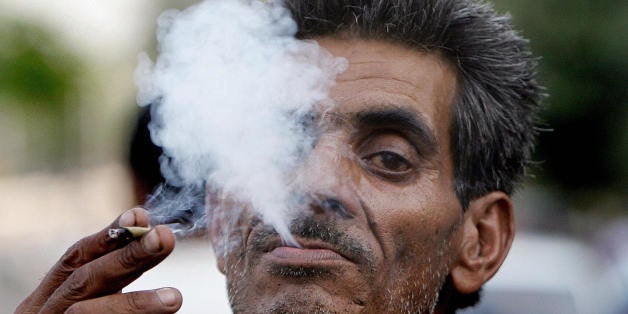
By Kate Kelland
LONDON, Sept 12 (Reuters) - Tobacco inflicts huge damage on the health of India's people and could be clocking up a death toll of 1.5 million a year by 2020 if more users are not persuaded to kick the habit, an international report said on Thursday.
Despite having signed up to a global treaty on tobacco control and having numerous anti-tobacco and smoke-free laws, India is failing to implement them effectively, leaving its people vulnerable to addiction and ill health, according to the report by the International Tobacco Control Project (ITCP).
"Compared with many countries around the world, India has been proactive in introducing tobacco control legislation since 2003," said Geoffrey Fong, a professor of psychology at Canada's University of Waterloo and a co-author of the report.
"However ... the legislation currently in place is not delivering the desired results - in terms of dissuading tobacco use and encouraging quitting."
As a result, India, with a population of 1.2 billion, currently has around 275 million tobacco users, the report said.
Harm from tobacco accounts for nearly half of all cancers among males and a quarter of all cancers among females there, as well as being a major cause of heart and lung diseases.
"The tobacco epidemic in India requires urgent attention," the report said, adding that by 2020, tobacco consumption will account for more than 1.5 million Indian deaths a year.
Worldwide, the number of deaths caused by tobacco is expected to rise from around 6 million a year now to more than 8 million by 2030, according to the World Health Organisation.
The ITCP India Survey conducted face to face interviews with 8,000 tobacco users and 2,400 non-users across four Indian states - Bihar, Madhya Pradesh, Maharashtra and West Bengal.
So-called smokeless tobacco - including chewing products such as gutkha, zarda, paan masal and khaini - is the most common form of tobacco use in India, with many poorer people and women preferring these over smoking cigarettes or bindis - small, cheap, locally-made cigarettes.
According to the Global Adult Tobacco Survey, 26 percent of adults in India consume smokeless tobacco - 33 percent of men and 18.4 percent of women. Smokeless tobacco can cause oral and other cancers, as well as other mouth diseases and heart disease.
Among several striking findings in the ITCP report was that, while many smokers and tobacco users said they knew of the health risks, only a small proportion said they would like to quit.
Up to 94 percent of smokers and up to the same proportion of smokeless users in the survey said they had no plans to give up.
Set against this, the report also found that up to 81 percent of smokers and up to 87 percent of smokeless tobacco users expressed regret for taking up the habit, and more than 90 percent of tobacco users and non-users in all four states had negative views on smoking and tobacco.
The report said that, while India has been a regional leader in enacting tobacco control legislation over the past 10 years, the laws are poorly enforced, regulations covering smoke-free zones are patchy, and tobacco remains relatively cheap.
Fong said the low percentage of people wanting to quit meant deaths from tobacco use were destined to stay high.
"If there is any single indicator of the urgent need for continued and strengthened efforts for strong, evidence-based tobacco control in India - this is it." (Editing by xxxx)
